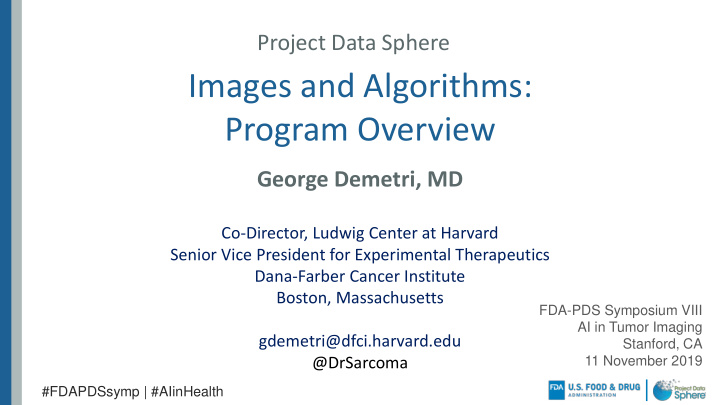



Project Data Sphere Images and Algorithms: Program Overview George Demetri, MD Co-Director, Ludwig Center at Harvard Senior Vice President for Experimental Therapeutics Dana-Farber Cancer Institute Boston, Massachusetts FDA-PDS Symposium VIII AI in Tumor Imaging gdemetri@dfci.harvard.edu Stanford, CA @DrSarcoma 11 November 2019 #FDAPDSsymp | #AIinHealth
DISCLOSURES FOR GEORGE D. DEMETRI, MD • Scientific consultant: Bayer, Pfizer, Novartis, Lilly, Roche, Epizyme, LOXO, AbbVie, EMD-Serono, GlaxoSmithKline, Janssen, PharmaMar, ZioPharm, Daiichi-Sankyo, Polaris, Sanofi, AdaptImmune, Ignyta, Mirati, ICON plc, WIRB-Copernicus Group, MJ Hennessey/OncLive, MEDSCAPE • Consultant/SAB member with minor equity holding: G1 Therapeutics, Caris Life Sciences, Champions Biotechnology, Bessor Pharmaceuticals, Erasca Pharmaceuticals • Independent Member of Board of Directors and Scientific Advisory Board Consultant with minor equity holding: Blueprint Medicines and Translate Bio 2
Images and Algorithms Program: Background ● Cancer imaging represents a universally-used clinical tool to assess patients endpoint ● Imaging is frequently used as a metric to assess the impact of anticancer therapy, for clinical care and/or for research trials ● The interpretation of cancer imaging studies can be more subjective than might commonly be known by the public
Imaging of Malignant Tumors (GIST) in a Phase 3 Clinical Trial
Imaging of Malignant Tumors (GIST) in a Phase 3 OPEN LABEL Clinical Trial No difference between central and local reads in standard drug arm Investigational Drug Arm Central Radiology Read Investigational Drug Arm Local (Central) Radiology Reads
Challenges with the Current State ● Central radiology reviews are slow, cumbersome and very expensive ● Clinical decisions often require rapid turn-around and extremely high reliability ● Assessment systems ignore much available data from imaging
Might ArtificiaI Intelligence/Machine Learning Improve the Consistency of Interpretation for Cancer Imaging? ● Inters-observer differences exist for many reasons ● Choice of target lesions to measure ● Choice of dimension to measure for complex 3D tumor mass ● Pattern recognition can be done in many ways to complement human judgement
Fig 1. The pigeons ’ training environment. Pigeons can be trained to recognize cancer vs. not-cancer in breast tissue Levenson RM, Krupinski EA, Navarro VM, Wasserman EA (2015) Pigeons (Columba livia) as Trainable Observers of Pathology and Radiology Breast Cancer Images. PLoS ONE 10(11): e0141357. doi:10.1371/journal.pone.0141357 http://journals.plos.org/plosone/article?id=info:doi/10.1371/journal.pone.0141357
Goals for PDS Images and Algorithms Program ● Bring together a community aligned to develop, test and validate novel tools for interpretation of clinical imaging ● Initial focus on CT imaging ● Collect validation sets of de-identified imaging studies curated with clinical reading used in FDA regulatory science assessments ● CT imaging of patients treated on clinical trials which have led to FDA approvals of drugs ● Make images accessible through consortium to develop tools which can transform imaging assessments
Active Issues for PDS Images and Algorithms Program ● Protection of patient privacy, secondary use consent, etc. ● Attention to highest quality standards and analyses to avoid risks of misleading secondary analyses of existing datasets ● How to structure access to facilitate most effective development of imaging assessment tools ● Linking curated clinical data to imaging time points, with connectivity to validated external readings (by experts) ● Costs of project support
Benefits should be worth the effort ● Current system is suboptimal ● External standards for imaging assessment are sought by FDA to speed effective therapeutic development ● Linking tools to clinically-validated data, with participation of FDA, should accelerate optimal testing and dissemination ● All stakeholders should benefit (especially patients and society)
Thank you all for joining today! ● We look forward to active participation and discussion ● Thanks again to Stanford for hosting ● Everyone is encouraged to think of next-step action items by which we can all work together to move these efforts forward
Recommend
More recommend